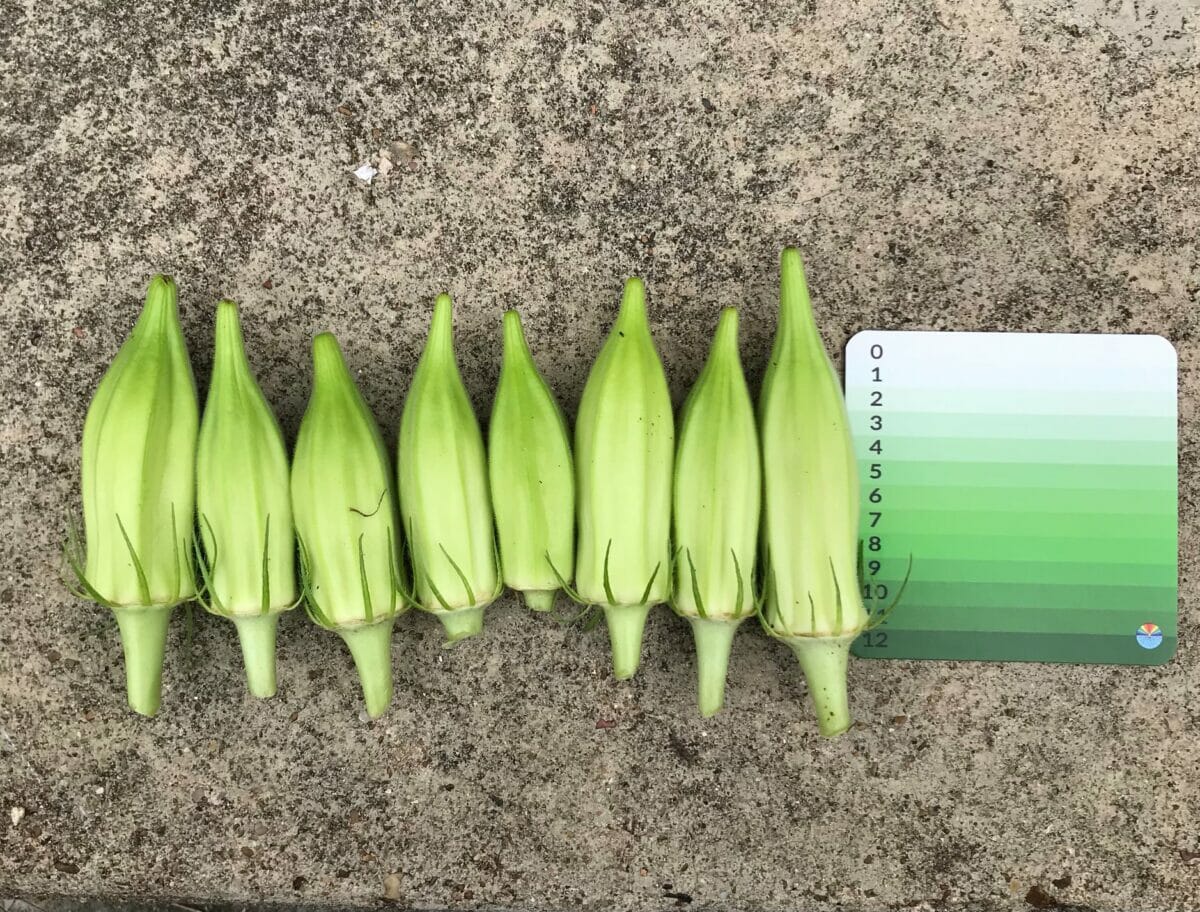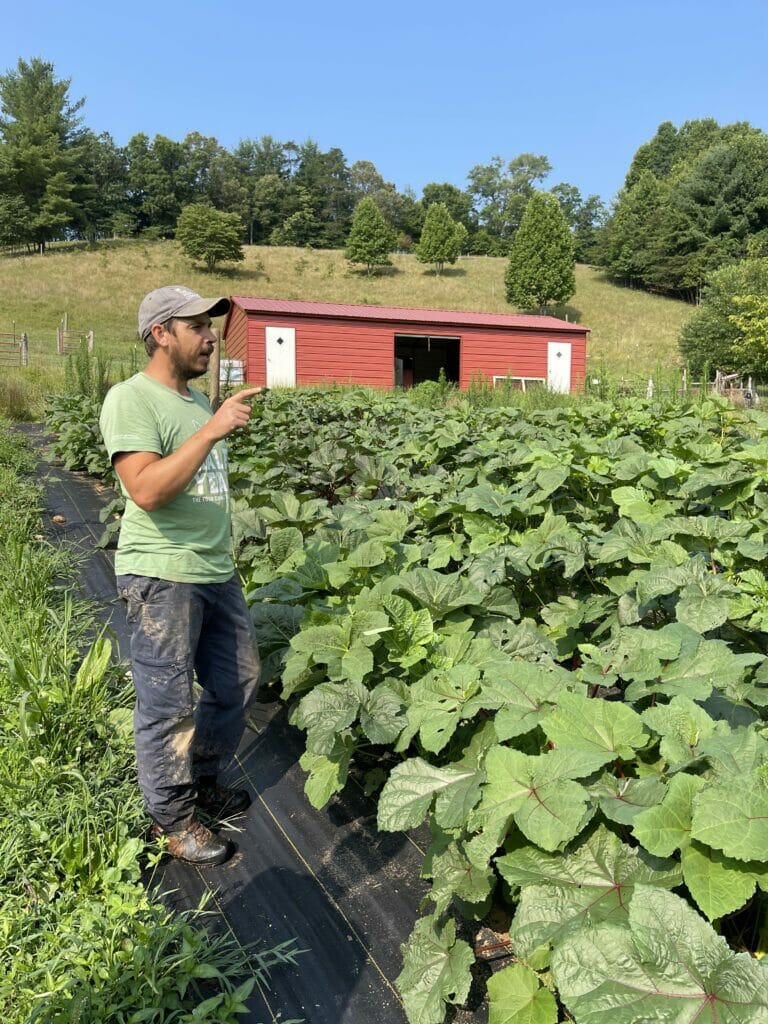Writer Chris Smith has launched an experiment to grow heirloom varieties of okra across the country.

Earlier this year, Chris Smith planted more than 100 varieties of okra on the farm he manages just outside of Asheville, North Carolina. As the executive director of the Utopian Seed Project, a nonprofit that aims to serve as a regional seed hub, he celebrates the diversity of crops such as collard greens, sweet potatoes and southern peas. But his ongoing okra trial, he says, is especially exciting.
Author of the James Beard Award-winning book The Whole Okra: A Seed to Stem Celebration, Smith didn’t exactly set out to become the “Okra Guy.” “I’m from England, and grew up not knowing what okra was,” he says. But after moving to North Carolina, where he and his wife received an okra plant as a wedding gift, the British ex-pat began to develop a fascination with the plant and its edible pods.
Originating in West Africa, okra was brought by enslaved Africans to the American South, where they cultivated it for themselves. It’s a staple ingredient in many southern dishes, including gumbo, the flagship dish of New Orleans.
Smith hopes to see the cultivation of okra—a drought-tolerant plant with beautiful blooms that resemble hibiscus flowers—reach other parts of the country. “When I planted my first American vegetable garden, I noticed everything was dying from blight or fungus,” says Smith. “Everything apart from okra, that is.”

Chris Smith shows off his okra. Photo by Shelby Vittek.
Smith planted his first okra trial with 76 different varieties in 2018 as part of the research for his book. This year’s trial expands on that, with heirloom okra varieties grown from seed, sourced from the Seed Savers Exchange or the USDA’s expansive seed collection. In a field on Franny’s Farm, a popular agritourism destination, Smith has several rows planted with 100 different varieties that produce okra of all colors—green, red, purple and even white.
Once the okra is ripe, Smith picks the pods and then evaluates their shape, coloring and flavor. Smith also notes the size of the plants’ leaves, of which he believes we should be eating more. “Why is there a market for okra but not for leaves?” he says. “We should be trying to popularize these things…and creating more potential for farmers.”
In addition to the large okra trial, Smith has honed in on one specific variety called the Whidby White, a pale, stubby okra pod with deep ridges whose seeds were donated to the Seed Savers Exchange in the 1980s by Vera Jarrard of Oakwood, Georgia. Very little was known about the variety then. In fact, the seeds were originally recorded as “Whitley White,” but after Smith delved into the history of the heirloom seeds, he learned the family’s name was Whidby, not Whitley, hence the name update.

Chris Smith is focusing on variety called the Whidby White. Photo by Melissa DeSa.
When Smith started growing the Whidby White okra, he noticed the plants were inconsistent when it came to their size, as well as the color and quality of the pods—likely the result of cross-pollination with other varieties. In an effort to obtain healthy, true-to-variety Whidby White okra seeds, Smith launched a community seed selection project this year.
Made up of more than 250 growers across the country, the participants have been growing out their seeds and comparing the experience on the Community Seed Savers Project group on Facebook. Members from South Carolina, Georgia, Texas, Pennsylvania and beyond regularly post photos of their plants and the pods against a color chart, asking questions and offering feedback. “I’ve been teaching seed saving for 10 years and people have never been so invested,” says Smith. “They’re all now actively participating in seed selection.”
Kristina Guidroz is one of those active participants. She and her family have grown okra for years on their urban homestead in Galliano, Louisiana. Earlier this year, she learned about the Utopian Seed Project’s unique Whidby White okra project. “We are always interested in unusual and heirloom varieties of plants,” she says. “Okra is a favorite to grow for us and we’re big on seed saving and the idea of bringing back an older variety was an interesting project.”
Guidroz’s Whidby White okra plants recently bloomed, and she now awaits the pods, whose colors she’ll document and seeds she’ll save to return to Smith, who patiently awaits their arrival. “We’re hunting for the palest pod,” says the okra enthusiast. “That’s the mission.”
Want to get involved with the next Community Seed Selection Project? Check out the Utopian Ultracross Collard CSS Project, which grew out of the Heirloom Collard Project.
Bravo. This is the first I’d heard about your project, but I am trying to save an heirloom okra seed here on our farm. These okra had been in the Hamilton family for several generations, and grown in this neighborhood by the family for 3 generations. When Ms. White Hamilton died I feared those seed would be lost, along with the family collard seed and climbing cornfield pea seed. However, two years later her daughter, who had checked on and maintained the family home, mentioned to me that she had found some seeds in the freezer and wondered if I… Read more »
I will begin vegetable farming in France in 2022. I’d like to plant some heirloom okra there and see if I can coax the French into eating some. (A Texan in France)
Why would you select for the “palest pod”? I would go for the absolute darkest green pod. With the exception of cauliflower, jicama, and potatoes, I can’t think quickly of any other nutritious white vegs.
I’ll stick with Clemson until this fad passes. Easy to grow, easy to save seed from. I have no idea if it is heirloom or not. I do know it works reliably, everywhere from my former ranch at 6500 feet in the eastern Sierra to 13 feet above sea level in Baja California now.
This is how the future is born. Unexpectedly.
I live here in the lowcountry St Helena Island South Carolina…… Okra and green tomatoes are like breeze off the ocean down here! I have the Clemson variety out in my garden now over seven and a half feet tall! Yes closely cultivated but producing like mad nonetheless!
The darker the vegetable, the more nutrition it contains. Iceberg lettuce will not keep you alive. Having said that, my favorite okra of many year’s standing now is silver queen. Really tender pods.
Can someone explain to me how slaves brought the seed over? Where they like “wait master, I have to go get some seeds to take with me.”?